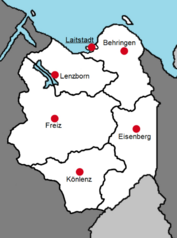East Besmenia: Difference between revisions
Neuleinster (talk | contribs) No edit summary |
Neuleinster (talk | contribs) No edit summary |
||
| Line 84: | Line 84: | ||
|common_languages = {{wp|Standard German|Besmenian}} | |common_languages = {{wp|Standard German|Besmenian}} | ||
|religion = | |religion = | ||
|demonym = East Besmenian | |demonym = East Besmenian, Besmenian | ||
|currency = [[Besmenian | |currency = [[Besmenian Schilling]] | ||
<!-- Titles and names of the first and last leaders and their deputies --> | <!-- Titles and names of the first and last leaders and their deputies --> | ||
|leader1 = [[Helmut Ritter]]<!-- Name of king or president --> | |leader1 = [[Helmut Ritter]]<!-- Name of king or president --> | ||
Revision as of 20:31, 14 June 2021
Federal Republic of Besmenia Bundesrepublik Besmenien | |
|---|---|
| 1920–1967 | |
 | |
| Capital | Laitstadt |
| Common languages | Besmenian |
| Demonym(s) | East Besmenian, Besmenian |
| Government | Federal parliamentary republic |
| President | |
• 1920-1930 | Helmut Ritter |
• 1930-1936 | Hans Saalmann |
• 1936-1942 | Georg Heimmann |
• 1942-1949 | Karsten Herzog |
• 1949-1955 | Peter Schneider |
• 1955-1961 | Oskar Stein |
• 1961-1967 | Thomas Albrecht |
| Prime Minister | |
• 1920-1924 (first) | Robert Falk |
• 1964-1967 (last) | Johannes Schmidt |
• upper house | Federal Senate |
• lower house | Federal Chamber |
| History | |
• Formation | July 2, 1920 |
• Introduction of the social market economy | June 1, 1925 |
| 1947 | |
| 1950-1954 | |
| September 14, 1967 | |
| Currency | Besmenian Schilling |
| Today part of | Besmenia |
| |
East Besmenia, officially the Federal Republic of Besmenia was a state during the Besmenian division. East Besmenia was founded on July 2, 1920 when the Besmenian Basic Law was went into effect. After the Besmenian reunification on September 14, 1967 West Besmenia joined the Federal Republic to form the today's Federal Republic of Besmenia.
The first half of the 1920s was characterized by poverty in East Besmenia. The country was even considered a failed state at that time. Prime Minster Heinz Dimmler, who was also Minister of Finance from 1924 to 1932, introduced the social market economy he had developed, in summer 1925. The new economic system surprisingly led to the East Besmenian economic miracle in early 1926, causing the economy to rise rapidly. East Besmenia was already considered one of the rich and economically strong countries in Nortua in the 1930s.

